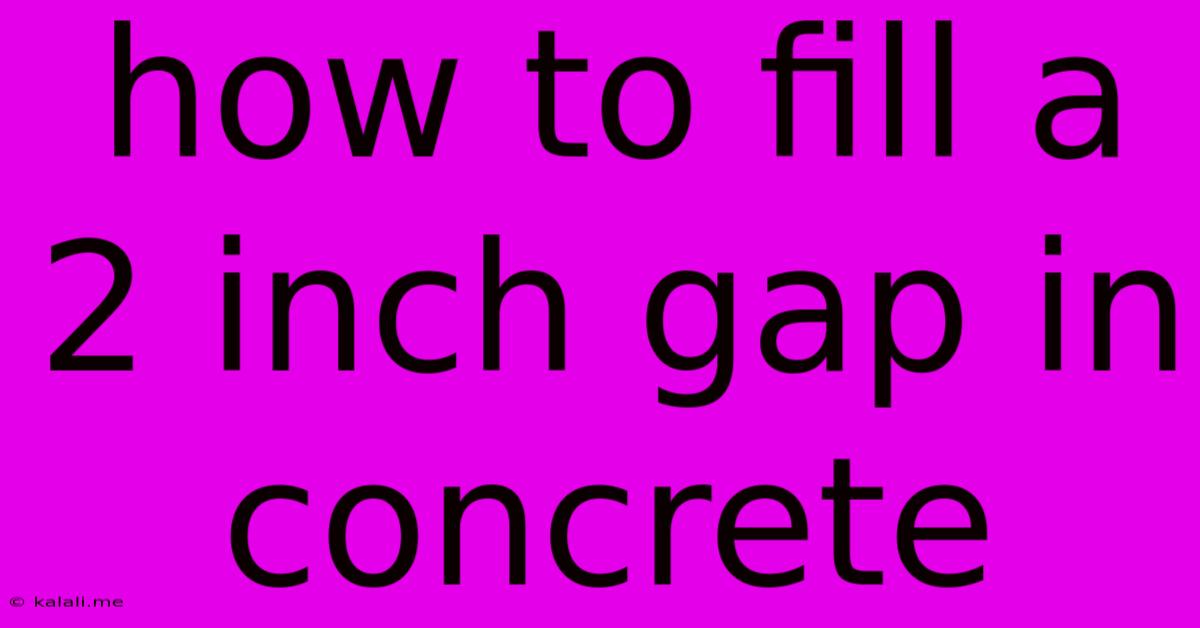How To Fill A 2 Inch Gap In Concrete
Kalali
May 24, 2025 · 4 min read

Table of Contents
How to Fill a 2-Inch Gap in Concrete: A Comprehensive Guide
Filling a 2-inch gap in concrete is a more significant repair than smaller cracks, requiring a different approach than simply using caulk or patching compound. This guide outlines the steps to successfully fill this larger gap, ensuring a durable and aesthetically pleasing result. This process involves careful preparation, choosing the right materials, and proper application techniques to prevent future cracking and deterioration.
Assessing the Gap and Choosing the Right Material
Before starting any repairs, it's crucial to fully assess the gap. Is it a clean break, or is there crumbling concrete? Is there any evidence of water damage or movement in the foundation? Understanding the cause of the gap is vital in choosing the appropriate repair method and material. A 2-inch gap often requires a more robust solution than simple patching.
For a gap of this size, several materials can be used, each with its own advantages and disadvantages:
-
Concrete Patching Compound: Suitable for smaller gaps and surface repairs, patching compound might not be strong enough for a 2-inch void. It's best for cosmetic fixes rather than structural repairs.
-
Self-Leveling Concrete: A good option for leveling uneven surfaces and filling gaps, self-leveling concrete can handle a 2-inch gap but may require multiple pours for best results. It offers a smoother finish compared to other options.
-
Hydraulic Cement: Excellent for larger repairs and structural integrity. Hydraulic cement is highly durable and resistant to water damage, making it a strong contender for a 2-inch concrete gap, especially if the gap is a result of structural movement or water damage.
Preparing the Gap for Repair
Thorough preparation is key to a successful repair. This involves:
-
Cleaning the Gap: Remove all loose debris, dirt, dust, and any crumbling concrete from the gap. Use a wire brush, a chisel, or a hammer and chisel to ensure a clean, sound surface. A pressure washer can be helpful for removing stubborn dirt and debris.
-
Moistening the Concrete: Dampen the surrounding concrete to help the new material bond properly. Avoid soaking the concrete; simply ensure it's adequately moist.
-
Creating a Key: If the gap is particularly deep and clean, creating a key will enhance the adhesion of the repair material. This involves roughing up the sides of the gap to provide a better mechanical bond.
Filling the Gap
The specific application method will vary depending on the chosen material:
-
Self-Leveling Concrete: Follow the manufacturer's instructions carefully. Usually, this involves mixing the concrete according to the instructions, pouring it into the gap, and allowing it to self-level. You might need to use multiple pours for a 2-inch gap. Use a trowel to spread the concrete evenly if necessary.
-
Hydraulic Cement: Mix the hydraulic cement with water according to the manufacturer's instructions. Apply it in layers, tamping each layer firmly to ensure complete compaction. This may require multiple layers to fill the 2-inch gap. Allow sufficient curing time between layers.
Finishing and Curing
Once the repair material has set, finish the surface to blend with the existing concrete. This may involve:
-
Grinding: Use an angle grinder with a concrete grinding wheel to smooth out any uneven surfaces.
-
Sanding: For a finer finish, sand the repaired area to achieve a smooth, even surface.
-
Sealing: Apply a concrete sealant to protect the repair from water damage and weathering.
Curing: Allow sufficient curing time as specified by the manufacturer of your chosen repair material. This is crucial for achieving the optimal strength and durability of the repair. Keep the repaired area moist during the curing period to prevent cracking.
Preventing Future Problems
Addressing the root cause of the gap is essential to prevent future problems. If the gap is a result of settling or structural movement, consulting a structural engineer might be necessary. Regular inspection and timely maintenance will also help prevent more extensive damage in the future.
By following these steps, you can effectively fill a 2-inch gap in concrete, ensuring a durable and long-lasting repair. Remember that safety is paramount; wear appropriate personal protective equipment (PPE), such as safety glasses and gloves, throughout the repair process.
Latest Posts
Latest Posts
-
Best Early Energy Systems In Skyfactory 4
May 25, 2025
-
Fundamental Group Of The Figure Eight Space
May 25, 2025
-
From The Sevenity Maxims Of Maximally Effecftive Mercenaries
May 25, 2025
-
Can You Put Frozen Meat In A Crock Pot
May 25, 2025
-
Sql Loop Thoug For Each Balue In The List
May 25, 2025
Related Post
Thank you for visiting our website which covers about How To Fill A 2 Inch Gap In Concrete . We hope the information provided has been useful to you. Feel free to contact us if you have any questions or need further assistance. See you next time and don't miss to bookmark.